RDP 9112: The Role of Superannuation in the Financial Sector and in Aggregate Saving: A Review of Recent Trends 3. Superannuation and the Financial Sector
December 1991
- Download the Paper 961KB
Although the assets of life offices and superannuation funds grew strongly through the 1980s, in both absolute terms and in relation to GDP, this growth was not dissimilar to that of other financial institutions.[4] The aggregate balance sheets of financial intermediaries rose from 124 per cent of GDP at the beginning of the decade to 200 per cent by 1990, with the banking sector growing particularly strongly. Graph 4 illustrates the similar patterns of banks' and superannuation funds' asset growth over the past three decades.

Source: See Appendix.
As a share of the total assets of financial institutions (Graph 5) superannuation funds grew modestly during the decade, from a low point of 18 per cent to about 21 per cent at the end of the decade – still lower than the share achieved in the early 1970s when the tax treatment of life insurance and superannuation had been most favourable.
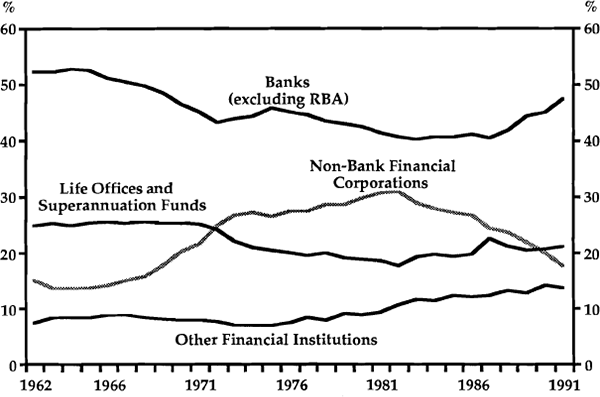
Source: See Appendix.
Banks increased their share of total assets by about 7 percentage points in the decade, largely at the expense of the non-bank financial intermediaries. This reversed the trend of the 1970s and, broadly speaking, reflected the undoing of the competitive advantage that restrictions on banks had given to their non-bank competitors. Part of the rise in the share of assets held by banks in recent years also reflected conversion of some of the non-bank intermediaries into banks, and the tendency for banks to take onto their own balance sheets some of the assets of their non-bank subsidiaries. The share of assets held by the small group of “other financial institutions” (mostly specialist funds management institutions operating as unit trusts) also increased during the 1980s.
The parallel expansions in the balance sheets of superannuation funds and financial intermediaries in general, occurred for related reasons. It has been argued in Section 2 that the acceleration in growth of superannuation funds was largely a result of the increased rates of return earned by those funds – a combination of high real interest rates and rapidly rising asset prices. These latter phenomena were closely linked to the expansion of financial intermediaries' credit which occurred at the same time. Although it is hard to identify the “exogenous” disturbances which would fully explain all this behaviour, the 1980s were characterised by balance sheet growth more rapid than nominal GDP in each of the major sectors – the household as well as the corporate and financial sectors[5] – and in that sense, the growth of superannuation and life offices was not unusual for the period.
Growth of superannuation has led some commentators to focus on the extent of competition between the superannuation sector and other financial intermediaries. On this issue, it is helpful to draw a distinction between the different types of markets in which these institutions compete for funds. At one end of the spectrum, banks offer deposits which come within statistical definitions of the money aggregates and which closely accord with the textbook functions of money. Monetary theory has traditionally emphasised that the demand for such assets is based on transactions requirements, and hence linked in aggregate to nominal income or spending.[6]
At the other end of the spectrum are assets and claims which are held as investments or as a store of long-term savings. In practice, of course, a range of assets is available to households, providing varying combinations of both characteristics. There would nonetheless seem to be a reasonably clear dividing line between superannuation funds, which are primarily concerned with longer-term savings, and other financial institutions, which primarily provide transactions balances and financial intermediation services. Competition between these core areas of business is probably fairly limited because it is unlikely that households would consider the two types of assets to be close substitutes. Differences in household behaviour with respect to the two types of assets were noted by Dilnot (1990), in a study of the pattern of households' asset holdings. He found that significant differences in savings across income groups tended to be reflected in their holdings of superannuation assets, but not in their holdings of deposits. This was argued to be consistent with the need for households to maintain minimal transactions balances, while longer-term savings were held in superannuation funds or other assets. The exception was the very high income category of households, which did hold large deposit balances.
Differences in the core businesses of banks and superannuation funds are emphasised by looking at the differing balance sheet structures of the two sets of institutions. On the liabilities side, banks differ by being able to issue deposit instruments for which there is a well developed market, and hence to engage in more-or-less continuous liability management.[7] On the other hand, balance sheets of life offices and superannuation funds effectively represent policyholders' equity, the size and growth of which is predominantly determined by the net inflow of contributions and the rate of earnings on their assets. Generally the borrowings of these funds are quite small, being limited by trust deeds and other regulatory requirements. This is not to say that these institutions don't compete for funds. They compete to raise their net contributions, often on the basis of their recent earnings records, and they can also compete for the increasingly important “discretionary” component of members' equity such as in rollover funds and insurance bonds. But they do not engage in liability management in the same sense as banks.
On the assets side, the major compositional difference is, of course, the importance of direct lending by banks, comprising more than 50 per cent of their total domestic assets, or 75 per cent if bill financing is included. Life and superannuation funds, by contrast, are relatively small direct lenders. Further details are provided in Graphs 6 and 7.
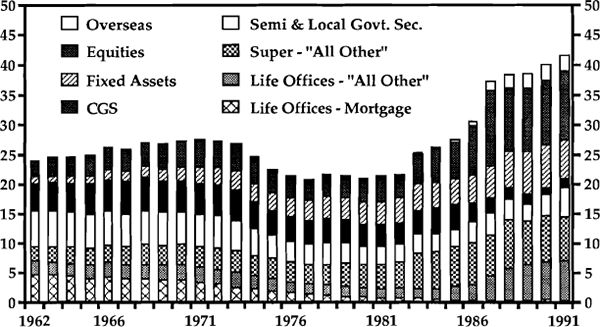
Source: See Appendix.
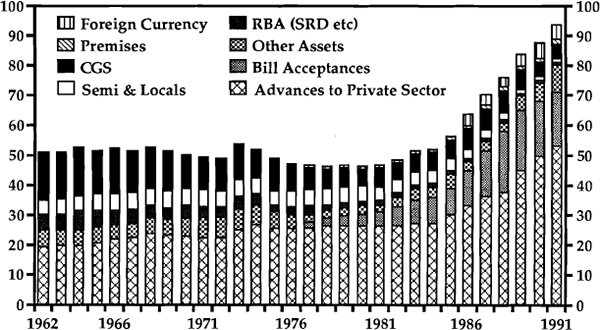
Source: See Appendix.
Given their generally long-term focus, life and superannuation funds have traditionally held a significant proportion of their balance sheets in fixed assets (mostly property) and equities; together these account for about 40 per cent of total assets. It is only in the last few years that they have acquired significant holdings of assets overseas, now about 10 per cent of the aggregate portfolio. Like banks, life offices and superannuation funds have also held a substantial proportion of their assets in Commonwealth Government securities, and semi- and local government securities, although this has gradually declined over time with the removal of the 30/20 rule and the diminishing stock of CGS outstanding relative to GDP in recent years. Mortgage lending, once a substantial part of the balance sheets of life offices, has declined to very low levels.
The data in Graph 6 also show about a third of total life and superannuation fund assets categorised as “other”. These “other” assets include deposits with financial institutions, holdings of bank bills and CDs, and loans to the public sector. Available data do not allow these asset holdings to be separately identified for life and superannuation funds as an aggregate, but recent data on superannuation funds outside life offices do provide a detailed breakdown of asset holdings for that group. Details are provided in Table 3.
| $ billion | Per cent of total | |
|---|---|---|
| Overseas Assets | 10.0 | 13 |
| Equities | 18.2 | 24 |
| Fixed assets | 10.3 | 14 |
| Commonwealth Government Securities | 3.8 | 5 |
| Local & Semi Government Securities | 6.2 | 8 |
| Other Loans to Public Sector | 7.0 | 9 |
| CDs and Deposits with Financial Institutions | 9.4 | 12 |
| Bills of Exchange (mainly bank bills) | 3.6 | 5 |
| Loans to Private Sector | 2.3 | 3 |
| Other (mainly unit trusts) | 5.0 | 7 |
| 76.1 | ||
Source: Assets of Superannuation and Approved Deposit Funds, ABS 5656.0, and ABS. |
||
This information suggests that direct lending by these superannuation funds is fairly small. Direct private sector loans form only about 3 per cent of their portfolio; loans to the public sector are somewhat larger, although some of this appears to represent deposits of public sector superannuation funds with State treasuries. Superannuation funds do, however, appear to be substantial indirect lenders, by buying bank bills (5 per cent of their portfolio) and by providing funds to the financial system in the form of CDs and deposits with intermediaries.
Although we have argued that there is little direct competition between their respective areas of core business, it is clear that there are some areas of overlap where banks and superannuation funds compete at the margin. For example, the increasing importance of rollover funds has helped to create a large “discretionary” component of superannuation assets which could conceivably be switched to banks if the tax incentives were different. Investment products such as insurance bonds would also come within this discretionary category. To the extent that the assets of such funds are held in bank securities, they could not be said to be diverting funds away from the banking system in aggregate, but it might be argued that they are replacing lower cost deposits which the banks would otherwise have attracted. In this way, the growth of superannuation might have the side-effect of raising banks' marginal cost of funds.
Another aspect of this issue concerns the division of banks' business between the household and corporate sectors. Although the banks were growing more rapidly than life and superannuation funds during the 1980s, it was the banks' corporate sector business which accounted for the bulk of that growth. Personal sector business, which is argued to be the more profitable area, represented a declining proportion of the banks' balance sheets, and did not keep pace with growth of the superannuation sector. Graph 8 shows that personal sector bank deposits in the 1980s remained fairly steady as a ratio to GDP, while life and superannuation assets were strongly increasing. Hence the latter represented an increasing share of the personal sector's balance sheet.
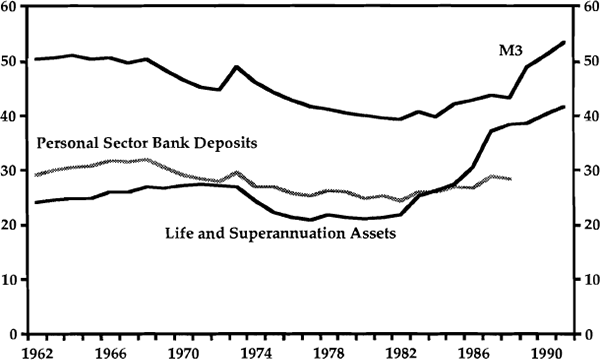
Source: See Appendix.
This shift in the composition of household assets can be thought of as resulting from a shift in the composition of their income. Wages and salaries were declining as a proportion of total household income, while earnings on assets (including superannuation assets) represented an increasing share. Since earnings on superannuation funds are automatically reinvested in those institutions, the period of high real interest rates had the more-or-less automatic consequence of increasing their share of the household sector's financial assets. Graph 9 illustrates this using financial flows data showing the shares of banks and superannuation funds in the market for household balances.[8] The graph shows an increase in the market share of life and superannuation funds when measured using contributions-plus-interest, but no trend increase in the contributions component. (The recent increase mainly reflects the growth of rollover funds, which has already been discussed. This increase is smoothed out by the 5-year-averages used in this graph, but is clearly temporary, as can be seen for example in the annual figures used in Graph 3.)
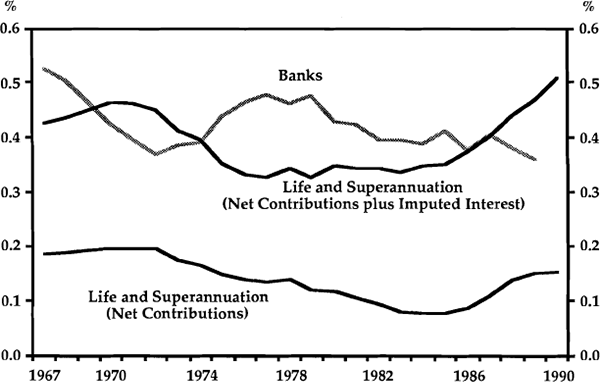
Source: See Appendix.
Footnotes
These data do not make any special allowance for the impact of bank and life office interests in other financial institutions. [4]
For a general discussion of why the ratio of financial assets to GDP fell through the 50s, 60s and 70s, and then rose strongly in the 1980s, see Grenville (1991). For a discussion of credit growth and corporate behaviour during the 1980s, see Macfarlane (1989). Callen (1991) discusses household behaviour and presents estimates of the expansion of the household sector's aggregate balance sheet during the decade. [5]
This literature is reviewed in Ostroy and Starr (1990). [6]
Banks have always had a reasonable degree of control over the asset side of their balance sheets but, as argued by Battellino and McMillan (1989), it was not until financial deregulation that they could manage the liabilities side as well, by effectively competing for funds at market rates. [7]
For the purposes of this graph, the market for household balances refers to the flow of household-sector funds into bank deposits, life and superannuation funds, building societies, cash management trusts, credit unions, common funds and friendly societies. [8]